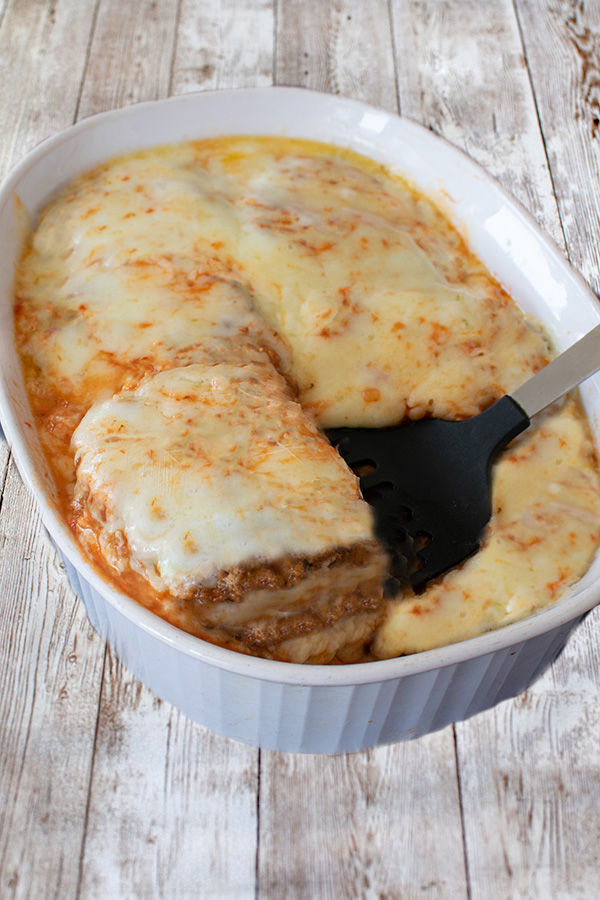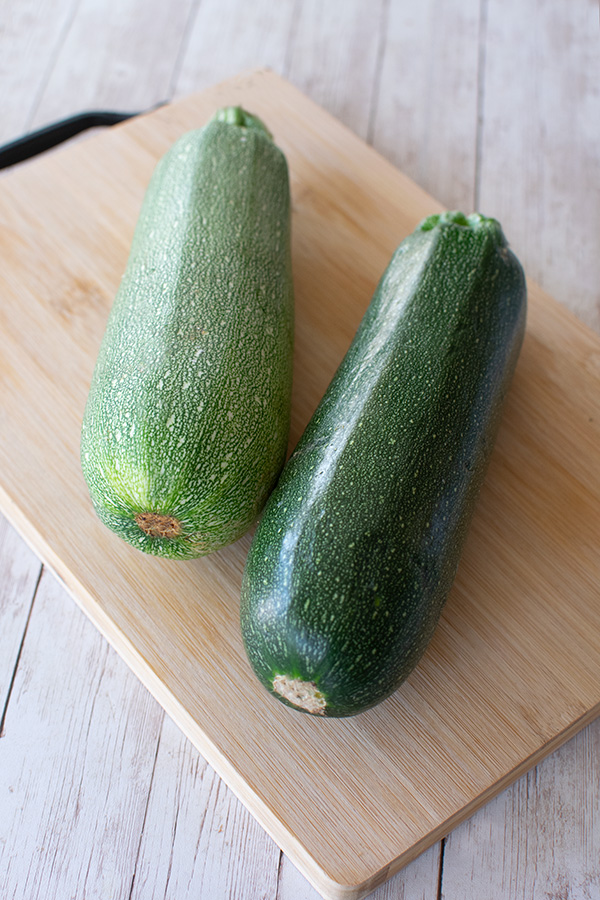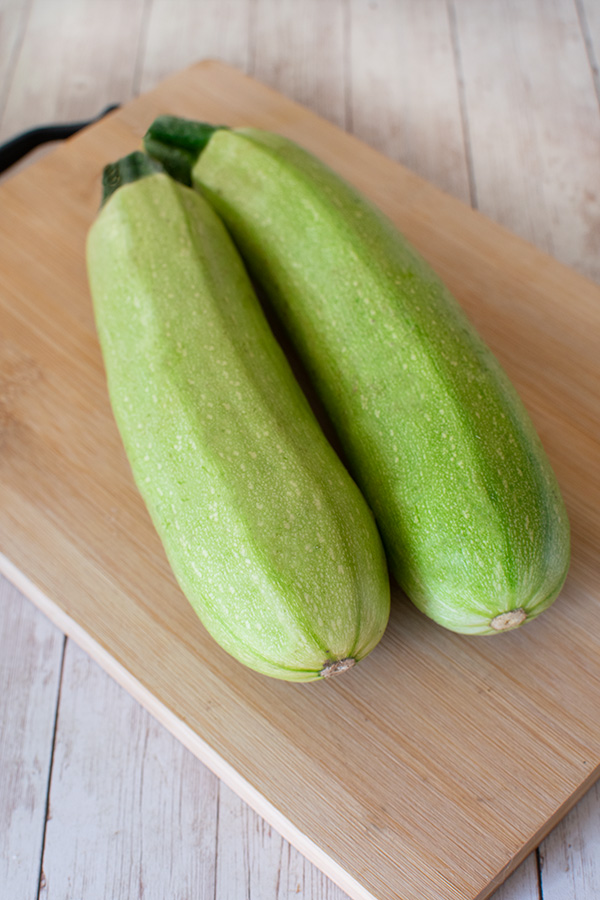Kosher for Passover Zucchini Parmesan is a simple to make, delicious dish with layers of breaded fried eggplant, a smooth tomato sauce, and gooey cheese.

Kosher for Passover Zucchini Parmesan is an easy-to-make dish.
When you read the ingredients and instructions, it may seem complicated and look a bit daunting, but while it is a little time-consuming, it really is a very simple recipe that everyone will love…especially during the week of Passover!
So, roll up your sleeves, turn on some tunes, and Kosher for Passover Zucchini Parmesan will be ready before you know it!
A little of my cooking background
I really wanted to title this blog “If I can make it, anyone can” because, honestly, if I can make it, anyone can.
I never really liked cooking, and when I was single, a meal for me meant grilled cheese, eggs, tuna, or something else that didn’t require effort or time.
When my kids were young, I was still able to get away with preparing only a small variety of easy meals, but the older they got, the more dishes I learned to make at their request.
Still, I insisted on keeping it simple.
Honestly, I never understood why some cooks unnecessarily complicate meals. I have seen recipes that have several ingredients that don’t really seem to add much, if anything, to the dish. So, why bother?
It has always been important to me that whoever eats at my table will have plenty to enjoy, and that includes my kids (I never agreed with the “You will eat what is served or you won’t eat” ideology), and, because I keep it simple, I can prepare a variety of dishes in a relatively short period of time.
I have a philosophy regarding being a great cook: Prepare food according to the tastes of those who will be eating it, and they will love your cooking!
As far as I am concerned, start with the basic ingredients that make the dish what it is, adapt according to taste, and voila! You are an amazing cook!
The bottom line is that while there are certainly delicate recipes out there for specialty dishes, making delicious meals doesn’t have to be complicated or time-consuming. It’s not difficult to impress—just make sure it tastes good.
While some of the recipes on my blog are more time-consuming than others, they are all tried and true easy-shmeezy!
Of course, one always has to consider the conditions under which they cook. Weather (humidity, heat, cold), different types of ovens, different quality of pots, etc.—all of which can affect your cooking and baking.
Nevertheless, as I said, if I can do it, anyone can!
Kosher for Passover Pantry Essentials (Suggestion)
As I learned to prepare more and more recipes for Passover, I also learned which basics and seasonings are good to have on hand to have the ability to make a dish on short notice—especially during the holiday—and not have to run out to the store or borrow from a neighbor.
While I will admit that I am not always prepared when one of my kids will ask for eggplant parmesan or something at the drop of a hat (which they have done), I dislike having to postpone making something just because the ingredients needed to make a reasonable meal were not readily available.
So, I maintain a selection of what I consider “kosher for Passover pantry essentials” in my refrigerator and on my shelves during the week of Passover (some of the dry goods, I keep from year to year, stored well).
While, of course, most of the essentials will not be needed just for any one recipe, at least some of them are needed for most recipes, and you would be surprised how many recipes can be made just with this list. So, if you make sure to have whatever you use regularly on hand, it can really save you time and effort.
Everyone has their favorite recipes, preferred seasoning, and just whatever they like to use to cook. Your own list should certainly reflect your own cooking tastes and style. Just make sure that everything is Kosher for Passover (KLP) and if you are Ashkenazi, that list will be shorter than if you are not.
Make sure to check with a qualified rabbi if you have any questions.
Following is a pretty comprehensive list of what you can choose from to keep on hand. I keep quite a bit of it.
Seasoning and flavoring:
- salt
- ground black or white pepper
- granulated garlic or garlic powder
- onion powder
- ground cinnamon
- sugar (granulated)
- brown sugar
- chicken consomme powder
- onion soup mix
- various herbs
- additional spices to adapt taste to preference
Misc:
- oil / margarine / butter / cooking spray
- potato starch as a thickening agent
- baking powder
- matzo cake meal (matzo meal, but ground into a powder)
- condiments, such as ketchup and barbecue sauce
- tomato sauce/tomato paste/canned tomatoes—diced or crushed/pasta sauce
- milk substitute (neutral flavor)
We always have eggs in the fridge and onions, and potatoes on our shelves (if we were not Ashkenazi, I would certainly keep rice as well).
In addition, having some fresh vegetables in the fridge, such as carrots, celery, tomatoes, bell peppers (red, green, etc), etc. can be very useful when putting together a quick, but delicious meal.
It is also a good idea to have some ground meat or chicken (breast, ground, or in parts), in the freezer for anyone who likes meat dishes in a snap.
Why are these pantry essentials beneficial to have on hand?
Personally, having the above ingredients in my kitchen is very advantageous, as I make a variety of dishes and use most of the items on the list regularly.
Whether or not buying a bunch of herbs, spices, etc. before you know what you are going to make for the week is workable for you depends on your own personal preference.
Of course, the more you cook and the more varied your recipes, the more you will use, and the more you will need.
If you plan your meals ahead for the week, you will be prepared with whatever else you might need that you wouldn’t even normally keep in your passover pantry.
If you do decide to keep them over from year to year, I would only do so if they can be sealed well (or better yet, stored in the freezer), because not only can weather have an affect on some of the spices and on the chicken consommé powder, but you will be surprised to know just how clever moths are at getting into sealed bags and how hot red pepper powder can attract little black bugs – YUCK!
Food on Passover
Torah-observant Jews do not eat chametz (the fermented products of five grains: wheat, spelt, barley, oats, and rye).
In addition, Torah-observant Ashkenazi Jews do not eat kitniyot (or kitniyos as pronouced in Ashkenazi Hebrew). These include legumes, corn, rice, and similar foods that were deemed forbidden to eat by rabbis in the medieval period and are still not eaten today. Sephardi and Mizrachi Jews do not follow this tradition.
Many observant Ashkenazi Jews will not even eat the derivatives of these kitniyot, while others do (each family holds their own traditions regarding this).
Then, there are Ashkenazim who don’t eat “gebrokts” (or gebrochts).
Gebrokts means “broken” in Yiddish, and in this case refers to matzo that has absorbed liquid. Not eating gebrochts is observed by many in the Hasidic Jewish community and Ashkenazim who have taken on this tradition where they basically don’t mix anything wet with matzo.
So, things like matzo sandwiches, fried matzo, and even matzo balls are a no-no for them.
There is a joke that sums it all up:
On Passover, we should remember people who have little to eat on this holiday. They are called Ashkenazim.
Over the years, I have learned to adapt “normal” food for Passover so that my family won’t complain about boring, tasteless, or repetitive meals.
I find that having good food and variety makes the week of Passover a very pleasant experience, and I hope this recipe will help make yours just that!
A little about zucchini

Zucchini is a type of summer squash.
The name zucchini is used in the United States, Canada, Australia, and New Zealand. However, in some other countries, such as Britain, Holland, and Malaysia, the term for this squash is courgette, taken from the French.
Like other types of squash, zucchini can be used in a variety of dishes. It can be fried, baked, broiled, breaded, etc. It can be sliced long way to prepare a dish or as disks.
Zucchinis contain vitamins and nutrients and are low in calories.

There are over a dozen types of zucchini. I personally use the dark green zucchini (All Green Bush Zucchini) or the fatter, light green (Magda) zucchini. The dark green tend to be a bit bitter compared to the light green.
Kosher for Passover Zucchini Parmesan

Layers of delicious breaded zucchini with tomato sauce and cheese.
Ingredients
- 2 - 2 1/2 pounds of zucchini (I use light green)
- 6 - 8 eggs (start with 6, add more if needed)
- 2 -3 cups matzo meal or matzo cake meal (start with 2, add more if needed) *
- 1 pound (or more as desired) of a mixture of shredded mozzarella and Parmesan, as desired (I only use mozzarella)
- 24 ounce jar of marinara or pasta sauce, kosher for Passover
- oil for frying, kosher for Passover
Instructions
Frying the eggplant
- Heat oil in a large frying pan on medium heat (approximately 1/4" - 1/3" high).
- Cut off the ends of the zucchini and peel (or leave the skin on, if desired - I leave the skin).
- Slice zucchini into slices of approximately 1/2" wide, lengthwise
- Pour eggs and mazto cake meal into separate bowls large enough to accommodate dipping the zucchini slices.
- Dip each slice into egg, then matzo cake meal, then egg again, making sure the slices are well coated.
- Place in pan with oil that has been heated on medium.
- Fry one side until golden brown, then flip and fry on other side until golden brown (you should be able to easily stick a fork through when they are ready).
- Remove fried zucchini and place on plate covered with paper towels to drain.
Preparing the Eggplant Parmesan
- Place a layer of fried zucchini on the bottom of a 9"x13", casserole dish, or other suitable size baking pan.
- Pour marinara or pasta sauce evenly over the layer of zucchini (determine how many layers of zucchini you will have and pour that fraction of sauce on to each - ex if you have 4 layers, then 1/4 of the sauce will be poured on each).
- Add the cheese over the sauce (again, divide according to the number of layers you have).
- Repeat until you have used all the ingredients.
- Place in oven and bake on 350° or until the cheese on top has melted well.
Notes
1) Feel free to use seasoned breadcrumbs, as desired.
2) You can choose to use one coat of egg and not redip after the matzo cake meal. If you choose to do this, you will need less eggs.
3) The amount of eggs and mazto cake meal you will need for the frying stage depends on how well you coat. That is why I write a range of amount for both. Chances are you will be left with some extra, but having a nice amount allows for easier coating and tarting with a smaller amount and have more at the read to add if needed helps prevent waste.
* The difference between matzo meal and matzo cake meal is that matzo cake meal is ground more fine.
Nutrition Information:
Yield:
6Serving Size:
1Amount Per Serving: Calories: 1219Total Fat: 20gSaturated Fat: 5gTrans Fat: 0gUnsaturated Fat: 12gCholesterol: 270mgSodium: 916mgCarbohydrates: 217gFiber: 12gSugar: 17gProtein: 40g